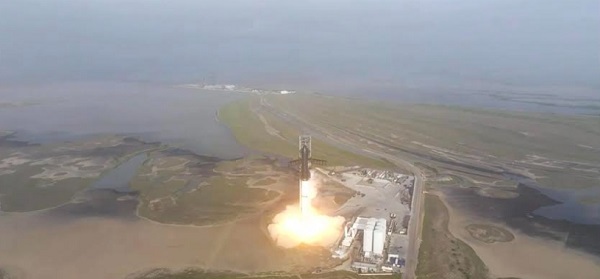San Francisco, (Samajweekly) SpaceX’s giant Starship rocket, which exploded after launch, has now come under the US Federal Aviation Administration’s (FAA) scanner for reportedly spreading plumes of potentially hazardous debris endangering human lives as well as habitats of animals.
On April 20, the first flight test of SpaceX’s fully integrated Starship and Super Heavy rocket, built to take humanity to the Moon, Mars and beyond, lifted off successfully.
Shortly after, it exploded and failed to reach orbit. However, the blast meant the test flight was successful, according to the company.
“The FAA will oversee the mishap investigation of the Starship/Super Heavy test mission,” the regulator said in a statement.
“A return to flight of the Starship/Super Heavy vehicle is based on the FAA determining that any system, process, or procedure related to the mishap does not affect public safety,” it said, adding that this is standard practice for all mishap investigations.
During the launch, dust and debris from the test reportedly rained down on residents in Port Isabel, Texas — a town roughly 10 km from the SpaceX launchpad, and also across Boca Chica’s beaches, which are nesting grounds for endangered animals, including birds and sea turtles, Space.com reported.
Ahead of the test flight, SpaceX CEO Elon Musk, acknowledged on Twitter Spaces that a Starship, which has 33 engines, is similar to ‘a box of grenades’, and that the Starship vehicle was not likely to reach orbit but was likely to explode.
According to Dave Cortez, a chapter director for the Sierra Club environmental advocacy group, Port Isabel residents reported broken windows in their businesses and ash-like particles covering their homes and schools, the report said.
In addition, SpaceX’s launchpad was also left with extensive damage that includes charred, twisted metal and shattered concrete. The force from the rocket’s engines also blew a hole in the launchpad and created a crater beneath it.
“Concrete shot out into the ocean,” creating shrapnel that “risked hitting the fuel storage tanks which are these silos adjacent to the launch pad”, Cortez was quoted as saying to CNBC.
The FAA noted that it is responsible for protecting the public during commercial space transportation launch and re-entry operations.
It means that before Starship’s next launch, it would need the regulator’s clean chit that the rocket will not affect public safety.
SpaceX aims to use Starship as a fully reusable transportation system to carry both crew and cargo to Earth orbit, help humanity return to the Moon, and travel to Mars and beyond.
Starship is the tallest rocket ever assembled. The fully integrated Starship and Super Heavy rocket stands 394 feet tall, and is about 30 feet in diameter.










